The Mail Rooms recalls this pub’s previous use as the town’s long-standing main post office.
Prints and text about The Mail Rooms.
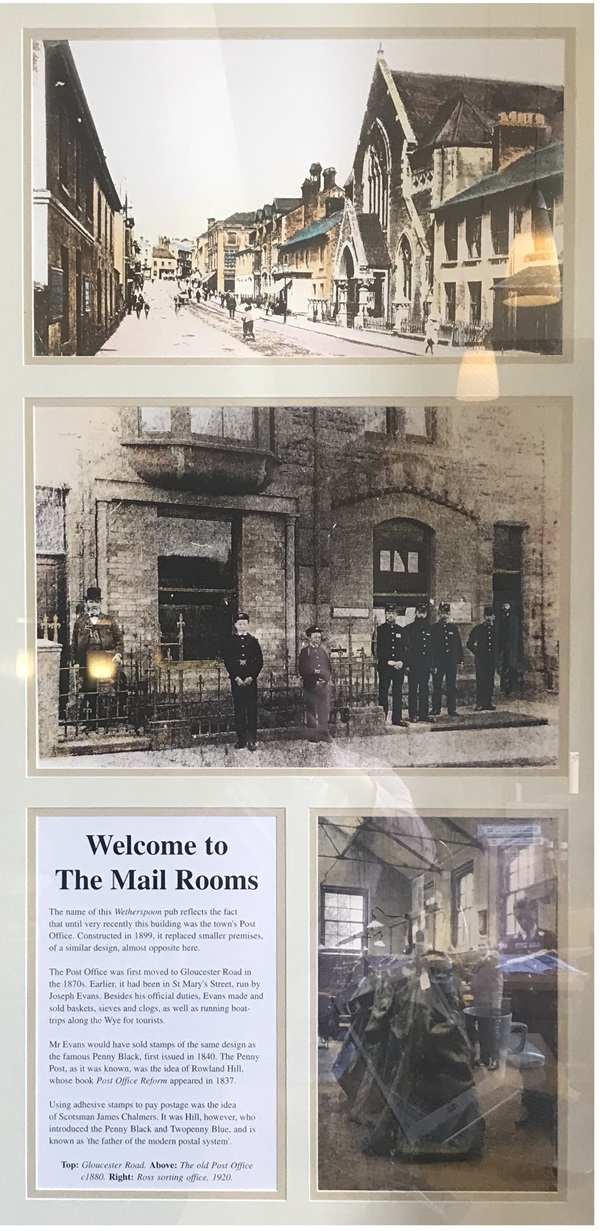
The text reads: The name of this Wetherspoon pub reflects the fact that until very recently this building was the town’s post office. Constructed in 1899, it replaced smaller premises, of a similar design, almost opposite here.
The post office was first moved to Gloucester Road in the 1870s. Earlier, it had been in St Mary’s Street, run by Joseph Evans. Besides his official duties, Evans made and sold baskets, sieves and clogs, as well as running boat-trips along the Wye for tourists.
Mr Evans would have sold stamps of the same design as the famous Penny Black, first issued in 1840. The Penny Post, as it was first known, was the idea of Rowland Hill, whose book Post Office Reform appeared in 1837.
Using adhesive stamps to pay postage was the idea of Scotsman James Chalmers. It was Hill, however, who introduced the Penny Black and Twopenny Blue, and is known as ‘the father of the modern postal system’.
Top: Gloucester Road
Above: The old Post Office c1880
Right: Ross sorting office, 1920.
Illustrations and text about John Kyrle.

The text reads: The old black and white house in the nearby Market Place was once the home of the philanthropist John Kyrle. Kyrle’s generosity brought him fame in spite of his personal modesty and he became known as “the Man of Ross”.
The poet Alexander Pope regularly visited Holme Lacy, near Hereford. Hearing of Kyrle’s reputation, he praised him in the third of his famous Moral Essays, entitled Of the Use of Riches.
Born at nearby Dymock in 1637, Kyrle inherited the Market Place house in the 1650s, and lived there until his death in 1724. Kyrle spent much of his time and energy, as well as most of his money, on improving the condition of the town and its people, especially the elderly, the poor and the sick.
Kyrle helped local schools, almshouses, and churches, but his major surviving gift to the town is The Prospect. These walled gardens were laid out in the 1690s with fountains and a reservoir fed from the River Wye. He also laid out a wooded walk running south to the river.
Not particularly wealthy, Kyrle is said to have funded his good works by persuading rich friends to open their purses. This is probably how the town’s water supply was financed.
Far right: Kyrle distributing break to the poor, c1730
Right: John Kyrle’s house (right) and the Market Hall, 1797.
Prints and text about Wye Tower.
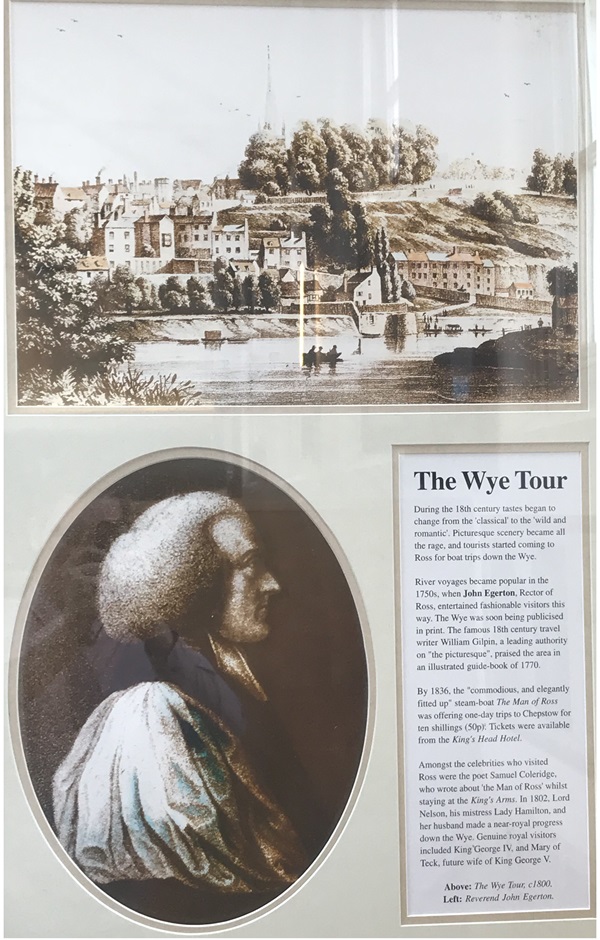
The text reads: During the 18th century tastes began to change from the ‘classical’ to the ‘wild and romantic’. Picturesque scenery became all the rage, and tourists started coming to Ross for boat trips down the Wye.
River voyages became popular in the 1750s, when John Egerton, Rector of Ross, entertained fashionable visitors this way. The Wye was soon being publicised in print. The famous 18th century travel writer William Gilpin, a leading authority on “the picturesque”, praised the area in an illustrated guide-book of 1770.
By 1836, the “commodious, and elegantly fitted up” steam-boat The Man of Ross was offering one-day trips to Chepstow for then shillings (50p). Tickets were available from the King’s Head Hotel.
Among the celebrities who visited Ross were the poet Samuel Coleridge, who wrote about ‘the Man of Ross’ whilst staying at the King’s Arms. In 1802, Lord Nelson, his mistress Lady Hamilton, and her husband made a near-royal progress down the Wye. Genuine royal visitors included King George IV, and Mary of Teck, future wife of King George V.
Above: The Wye Tour, c1800
Left: Reverend John Egerton.
A photograph and text about Thomas Blake.
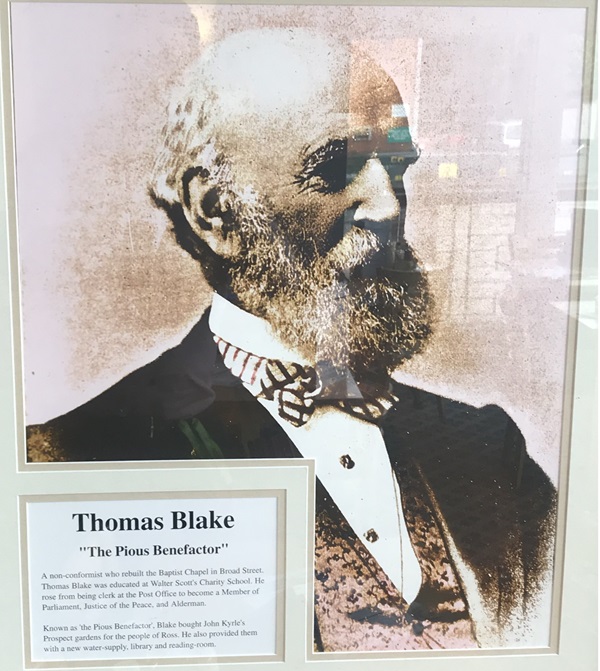
The text reads: A non-conformist who rebuilt the Baptist Chapel in Broad Street. Thomas Blake was educated at Walter Scott’s Charity School. He rose from being clerk at the Post Office to become a Member of Parliament, Justice of the Peace, and Alderman.
Known as ‘the Pious Benefactor’, Blake bought John Kyrle’s Prospect gardens for the people of Ross. He also provided them with a new water-supply, library and reading-room.
Illustrations, prints and text about benefactors.
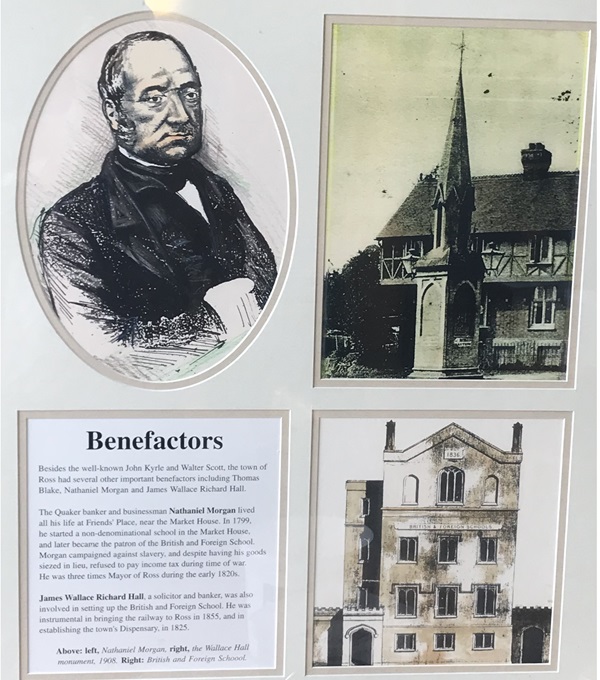
The text reads: Besides the well-known John Kyrle and Walter Scott, the town of Ross had several other important benefactors including Thomas Blake, Nathaniel Morgan and James Wallace Richard Hall.
The Quaker banker and businessman Nathaniel Morgan lived all his life at Friends’ Place, near the Market House. In 1799, he started a non-denominational school in the Market House, and later became the patron of the British and Foreign School. Morgan campaigned against slavery, and despite having his goods seized in lieu, refused to pay income tax during time of war. He was three times Mayor of Ross during the early 1820s.
James Wallace Richard Hall, a solicitor and banker, was also involved in setting up the British and Foreign School. He was instrumental in bringing the railway to Ross in 1855, and in establishing the town’s Dispensary, in 1825.
Above: left, Nathaniel Morgan, right, the Wallace Hall monument, 1908
Right: British and Foreign School.
Prints, illustrations and text about the centre of town.
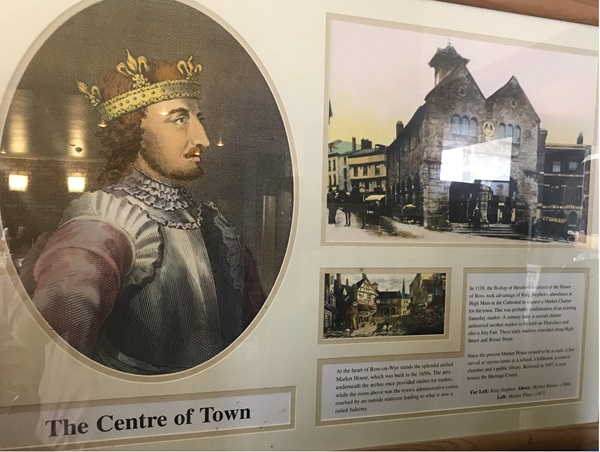
The text reads: At the heart of Ross-on-Wye stands the splendid arched Market House, which was built in the 1650s. The area underneath the arches once provided shelter for traders, while the room above the town’s administrative centre, reached by an outside staircase leading to what is now railed balcony.
In 1138, the Bishop of Hereford, overlord of the Manor of Ross, took advantage of King Stephen’s attendance at High Mass at the Cathedral to request a Market Charter for the town. This was probably confirmation of an existing Saturday market. A century later, a second charter authorised another market to be held on Thursdays and also a July Fair. These early markets extended along High Street and Broad Street.
Since the present Market House ceased to be a court, it has served at various times as a school, a ballroom, a council chamber and a public library. Restored in 1997, it now houses the Heritage Centre.
Far left: King Stephen
Above: Market House, c1900
Left: Market place c1871.
Illustrations, a photograph and text about Walter Scott.

The text reads: On the Old Gloucester Road, near this Wetherspoon pub, is the building which opened in 1799 to house Walter Scott’s Charity School. Though the School closed in 1928, funds remaining from Walter Scott’s legacy are still distributed as an educational charity.
Born in Ross in 1716, Scott had received “the little learning I have” at the town’s Blue Coat School. Scott’s learning was “little” as he ran away from Ross at an early age, fearing punishment for the theft of some pears. He apprenticed himself to an uncle, a London plasterer, and eventually inherited his business.
He returned to Ross in 1785, aged 70, the year before he died, to find his former school “quite come to nothing”. He was determined to revive it and bequeathed funds to provide a yearly income of £200.
The school was to educate and clothe 30 boyds and 30 girls from Ross, aged between 6 and 14. The highlight of the school year was Founder’s Day, 4th December. This was the day of Walter Scott’s death.
Top: A pupil at Walter Scott’s School, 1863
Centre: Walter Scott’s Charity School 1820
Above: Pupils at Walter Scott’s, c1900.
External photograph of the building – main entrance.
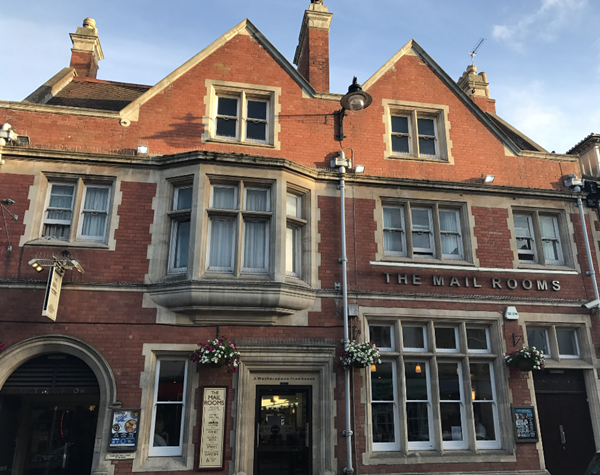
If you have information on the history of this pub, then we’d like you to share it with us. Please e-mail all information to: pubhistories@jdwetherspoon.co.uk